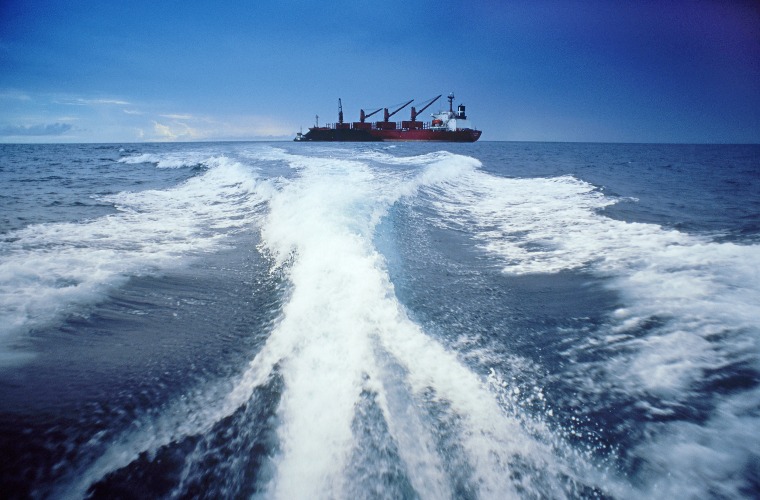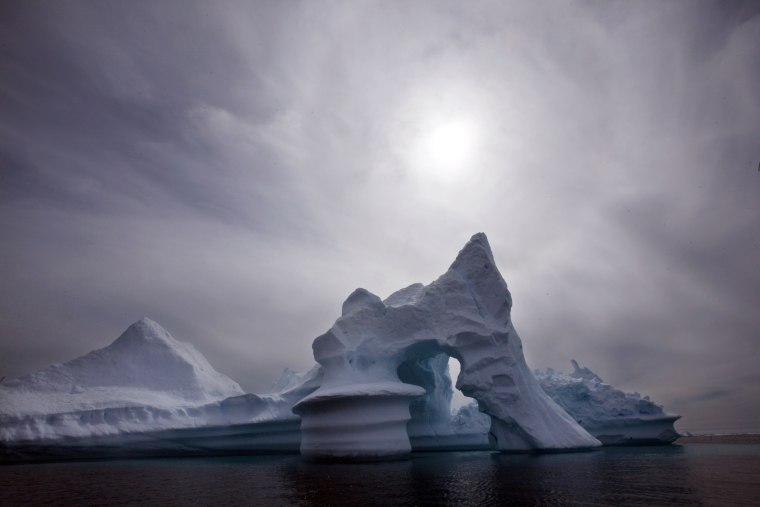As the ravages of climate change become ever more apparent, some scientists are contemplating an array of possible technological fixes — most of which would have sounded like science fiction just a few years ago (and in many cases still seem pretty far-fetched). But drastic times may call for drastic measures, and the time may have come to tinker with the climate in order to keep the planet livable.
“Geoengineering” is the catch-all term for attempts to alter Earth’s climate in order to mitigate the effects of global warming. And, not surprisingly, it’s been controversial from the start. Critics have derided it as “playing God” with the environment, and the potential risks are almost too many to tally — even its proponents stress that the consequences of large-scale climate intervention are impossible to foresee. But as the signs of global warming multiply, geoengineering is beginning to seem like a plausible solution — or at least part of a solution — to today’s climate woes.
By now, those woes are painfully familiar: Temperatures in the Arctic have risen as much as 35 degrees Fahrenheit above their historical averages. Arctic sea ice, meanwhile, has dropped to its lowest level on record. And the rate of global sea level rise has doubled over the last two decades. These effects and others are forcing scientists to give serious thought to climate interventions that not long ago would have been dismissed as preposterous.
Hacking the Climate
Many different strategies for geoengineering have been put forward. Most of them confront some aspect of the “greenhouse effect” — the warming of the planet that results from heat getting trapped by the atmosphere. Earth has always experienced some degree of greenhouse warming, but the problem has accelerated since the Industrial Revolution, when we began releasing artificially produced greenhouse gases, especially carbon dioxide, into the atmosphere. The result — global warming — is now one of the greatest threats to life on Earth.
One way to reduce greenhouse heating would be to curb carbon emissions — something that, collectively, we’ve pretty much failed to do. The next best thing would be to neutralize the effect of the carbon we’re releasing. Several ways to do that have been proposed: planting trees on a massive scale; burying carbon at sea; even sprinkling iron filings over the ocean to simulate the effect of carbon-neutralizing plankton.
But most proposals, rather than tackling the carbon issue, attempt to simply lower the amount of solar radiation reaching Earth.
One of these more extravagant solar engineering proposals is a plan to position giant mirrors in space, each with orbits that keep them between the sun and Earth to intercept some of the sun’s rays before they reach our planet. Or we might use trillions of oversized, Frisbee-like disks for the same purpose. A more down-to-earth proposal is called “wake whitening” — manipulating the wake created by large cargo ships so that they’re more reflective and last longer. According to a recent study, wake whitening could cool the planet by one degree Fahrenheit over the next 50 years.

But the proposal that seems to be gathering the most steam involves spraying small particles into the air, increasing the atmosphere’s “albedo” — a technical term for its reflectivity — in order to send a greater proportion of the sun’s rays back into space.
Balloons Away!
The first serious geoengineering experiment may come in less than a year. Scientists at Harvard University plan to use a balloon-borne probe to inject water vapor into the stratosphere above the Arizona desert to reflect some of the sun's light away from Earth. (The work is currently supported by internal Harvard research funds, but the university's newly established Solar Geoengineering Research Program has raised $7.3 million from an array of foundations and private donors, and they hope to reach $20 million over the next seven years.)
The Harvard study “represents the transition from this being a theoretical set of thought experiments, or computer simulations, to actual work in the atmosphere,” says Eli Kintisch, a correspondent for Science magazine and the author of a 2010 book on geoengineering titled "Hack the Planet." Geoengineering was “on the fringe” when he started researching his book, Kintisch says. “Now just about every major science body — the National Academies of Science, the Royal Society in the U.K. — has endorsed the need to study it.”
The key word is “study.” The Harvard scientists stress that the planned experiment isn’t necessarily the beginning of a large-scale effort to disrupt the planet’s atmosphere. Far from it. Instead, the immediate goal is simply to better understand the processes involved.
“There are a staggering number of uncertainties at the moment,” says Frank Keutsch, a professor of engineering and atmospheric science at Harvard, and one of the scientists planning the geoengineering experiment.

Some of what we know about the underlying science comes from nature’s own versions of this experiment: Back in 1991, Mount Pinatubo erupted in the Philippines, spewing millions of tons of sulfur dioxide and other particles into Earth’s atmosphere, causing a half-degree drop in the planet’s average temperature. And in 1815, Mount Tambora, in Indonesia, blew its top in one of the largest known explosions in history. The resulting cloud of debris caused crops to fail thousands of miles away (the following year became known as “the year without a summer”).
The Harvard experiment will be far more modest in scale. The plan is to release one kilogram (just over two pounds) of water in the stratosphere, creating a plume of water vapor a kilometer long and 100 meters wide. The balloon can then be steered back into the plume to measure the effects. Later tests may use other substances, such as calcium carbonate or aluminum oxide. But even then, the scientists stress, the amount of material released would be less than that produced by a commercial jetliner during one minute of flight.
If the experiments are successful, we can imagine what it might be like to implement a similar plan on a larger scale. Our grandchildren might one day peer skyward and gawk at a fleet of jets as they traverse the stratosphere, releasing precisely-measured doses of particles on a regular basis. Journalist Graeme Wood painted an even more dream-like scenario in which factories on the ground pump sulfur dioxide upward through miles-long hoses, their nozzles held aloft by high-flying zeppelins.
Or not. Many experts believe that large-scale geoengineering either won’t succeed or shouldn’t be attempted in the first place.
No Silver Bullet
Any sort of tinkering with the planet’s climate is “a very controversial topic, for good reasons,” Keutsch says. “Even in the best-case scenario, geoengineering through albedo modification is not a solution to the problem.” Solar geoengineering would do nothing to lower the concentration of atmospheric carbon dioxide and other greenhouse gases, which means the atmosphere would continue heating up the moment the intervention was over. It also wouldn’t slow the acidification of the oceans, a result of the buildup of carbon dioxide in the atmosphere.
“You’re really not addressing the cause of the problem; you’re only addressing the symptoms,” Keutsch says. Drawing an analogy, he adds, “Sometimes there’s a reason to take painkillers. But painkillers have all kinds of consequences.” And with the pain under control, he explains, the patient may end up doing things that exacerbate the original condition, making the patient more reliant on medication and eventually making the underlying problem even worse.
"This is a very real risk,” he says.
In other words, the public might be lulled into believing that a “technological quick fix” is at hand — and that no other measures are needed to save Earth from potentially catastrophic climate change.
Related: How We're Teaching Endangered Reefs to Help Themselves
“The execution of small-scale experiments could create, in the public’s mind, the idea that solar geoengineering could reduce or eliminate the need to mitigate carbon dioxide emissions," Kintisch says. "Some in the public might come to believe that there’s a quick fix, or a silver bullet — and therefore the hard work of changing our energy system, to become cleaner, could be sidelined or curtailed.”
If some form of geoengineering turns out to be effective, it would most likely end up being one small step in the overall strategy for combatting climate change — a strategy that would almost certainly still call for sharp reductions in greenhouse gas emissions.
“Even scientists who begrudgingly or reluctantly support research into geoengineering believe that it should be just one of the tools being considered for dealing with our changing climate,” Kintisch says.
"You're really not addressing the cause of the problem; you're only addressing the symptoms."
And then there are the risks. Experts worry that large-scale solar geoengineering could disrupt rainfall patterns, possibly triggering droughts. There are also concerns over possible effects on the ozone layer, which absorbs most of the sun’s ultraviolet radiation. As well, any disruptions that occur would very likely cross national boundaries, which means political repercussions are almost guaranteed.
As meteorologist Jason Samenow wrote in the Washington Post recently: “It’s akin to seeking global agreement on the mechanics of playing God with the planet — establishing a world government to set and control a thermostat for Earth, and amicably living with whatever consequences.”
For that matter, there’s nothing to stop a rogue nation — or a rogue billionaire — from implementing some version of a geoengineering plan on their own. No wonder many scientists are all calling for international dialogue on how large-scale geoengineering ought to be managed.
Meanwhile, Back at the Lab
Before the Harvard scientists release anything into the atmosphere, however, there’s more work to be done in the laboratory as they try to determine which particle, or which combination of particles, might have the optimum effect. But lab tests on their own can never be adequate.
“You can never be sure that your laboratory system faithfully reproduces every aspect of the atmosphere,” Keutsch says. Even if he and his colleagues find a particle that seems to work well under lab conditions, they would need to conduct real-world tests to see how it plays out in Earth’s atmosphere. And even then, he cautions, any serious geoengineering program would be immeasurably more complex than these simple initial experiments.
Related: What Lies Ahead for the Earth's Shifting Continents?
“The notion that just one type of geoengineering, with one type of particle, is the best-case scenario, just seems extremely unlikely,” he says.
As risky as geoengineering may seem at the moment, many scientists appear to be cautiously accepting the idea that we should study the underlying science in more detail. The Harvard experiment will be a small step in that direction.
“I’m in favor of new knowledge, and learning about what the effects might be,” says Kimberley Strong, an atmospheric physicist at the University of Toronto. The Harvard experiment, she says, is “a valid undertaking.” But, she adds, “We need to think very carefully before doing things on a large scale and consider what the potential repercussions might be. History is littered with ‘fixes’ that have caused new problems.”
Dan Falk (@danfalk) is a science journalist based in Toronto. His books include "The Science of Shakespeare" and "In Search of Time."
